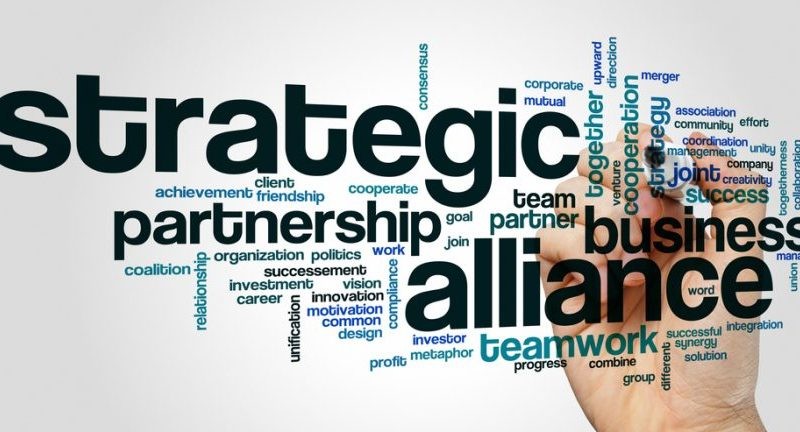Strategic alliances are not a recent development. Companies have been cooperating for decades; examples of these partnerships include Starbucks and Google, Spotify and Uber, and McDonald's and Coca-Cola. Even while some of these businesses might not seem to be very similar, the most successful strategic alliances discover innovative methods to reach new consumers and possibly even break into untapped areas. When you work together, you can increase brand recognition and make sure that both businesses have successful futures.
What do strategic partnerships function?
A strategic partnership is an alliance of two or more organizations that pools capital, technology, and/or resources in order to succeed together. Non-competing companies typically decide to collaborate in order to reduce risks, including increasing marketing efforts in uncharted terrain, which may be an expensive venture with little assurance of success.
In this case, collaborating with a strategic marketing partner is an excellent method for a company to increase return on investment (ROI) as it enables it to grow its clientele rapidly and affordably.
Co-branding is another term that may be used to describe a strategic relationship. It makes information, services, and other resources available to businesses that they may not otherwise have. Then, any company may expand while incurring lower expenses.
There are six types of strategic alliances:
Integration partnerships: This entail combining disparate businesses or services to simplify the lives of their clients. When sales-as-a-service providers develop APIs to interface with other services, they frequently form integration agreements. One of the top email marketing services, for instance, may collaborate with many content management system providers to enable users to easily connect, edit, or transfer data between programs.
Tech partnership: In this kind of agreement, one company hires another to provide technical support. This may be as easy as two companies sharing the cost of a costly piece of equipment, like a large-format printer, and sharing the use of the same office building.
The Financial partnership: In order to generate value for their company through the evaluation of datasets, businesses typically collaborate with independent accounting or financial firms. In order to assist the business's leaders in making choices, the partnered financial organization often does a market study, audits the company's finances, and produces forecasts and insights.
The Supply partnership: In this kind of arrangement, a manufacturer and a vendor work together to stock a certain product on the company's shelves. For instance, an electronics retailer and an audio manufacturer may collaborate to offer the maker's line of headphones alone. Another illustration would be an office building's cleaning supply inventory, which is solely stocked by one company.
The Supply chain partnerships: These are common among larger corporations and entail several firms collaborating to produce a product. For example, a television firm could collaborate with many companies to produce its product: one company designs the screen, another makes the electronic parts, and a third company makes the plastic or metal casing.
Partnership in marketing: This type of relationship is also quite popular and may be as simple as two companies promoting each other's goods or services to increase their market share. A local general contractor and an interior designer are an example of a best-practice marketing cooperation as they both work in related sectors.
Which types of Partnerships are strategic?

Strategic alliances are something that many elite businesses frequently participate in. Even if your company is undoubtedly smaller than the ones listed below, you can still get inspiration from these. Think about how you could implement such policies at your own business.
Pottery barn and sherwin-williams
Both sides profited from this strategic alliance, which attracted clients interested in home renovation projects. Users may match Sherwin-Williams paint colors to available Pottery Barn furniture pieces on the Pottery Barn website. A blog including do-it-yourself painting project advice was also linked on the website.
Uber and Spotify
Uber and Spotify collaborated to provide users the option to choose the music for each journey, despite the fact that the two services don't appear to have anything in common. Why is this arrangement logical? While Uber allows users to listen to their own playlists, Spotify offers a distinctive experience in a crowded market.
Eddie Bauer and Ford
The automobile company collaborated with the clothing conglomerate to establish distinctive promotional prospects for both entities. Premium Eddie Bauer features, such as leather seats, were installed in some Ford cars, and the Ford emblem was placed on Eddie Bauer baggage and accessories. In this way, both businesses were able to raise awareness of their brands.
All of the aforementioned collaborations were official setups subject to contracts. A formal agreement should be in place to safeguard your company. That will be especially helpful if you ever need to leave a partnership, which can be difficult depending on how closely related the two businesses are.
What benefits do strategic partnerships offer?

Strategic partnerships are fundamentally symbiotic relationships, as suggested by the definitions given above. Collaborating may benefit all parties involved, as it can save expenses and pool resources. We'll go into more depth about a few of the less obvious advantages below.
Attracting new clients
Extending your reach is a critical component of business development. Gaining access to new clients through a strategic relationship may also provide a chance for cost-free promotion. You might be able to contact their customers when you collaborate with another company. This is a really powerful marketing tactic since it doubles your clientele by expanding your reach.
Possibility of expanding into other markets
If you locate the correct strategic partner, your business may be able to enter new markets in addition to gaining access to new consumers. Take Starbucks and Google as an example. Google is definitely not the first firm that comes to mind when you think about coffee. However, the two massive brands may enter each other's marketplaces when they collaborate.
What if, for instance, Google developed virtual coffee shops that looked and felt just like Starbucks? By doing so, Starbucks would enter the metaverse, a business that Google is well-versed in but in which it is new. Similar to how it doesn't usually target coffee lovers, Google could be able to do so through a collaboration with Starbucks, opening up new avenues for growth.








